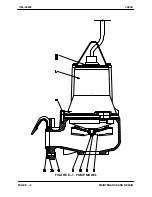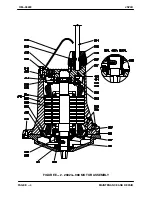
OM−05229
JSV3H
PAGE B − 2
INSTALLATION
PUMP INSTALLATION
Lifting
Use lifting equipment with a capacity of at least
990
lbs. (450 kg.)
. This pump weighs approximately
198 lbs. (90 kg.)
, including the weight of standard
cable, but
not
including the weight of customer-
installed accessories such as piping. Discharge
hose or piping must be removed before attempting
to lift the pump.
Positioning the Pump
NOTE
Before installing and operating the pump, check
the direction of impeller rotation to ensure that the
pump is properly wired at the control box. See
IM-
PELLER ROTATION
,
SECTION C.
This pump is designed with an automatic sub-
mersible connection which allows the pump to be
removed and/or installed without personnel enter-
ing the wet well.
The pump is equipped with a rail guide shoe which
connects to the discharge optional elbow/
baseplate. When lowered into place, the pump is
automatically and securely connected to the el-
bow/baseplate and the piping system. See Figure
B−1 for a typical elbow/baseplate installation. For
information on installing the guide rails, see the lit-
erature accompanying them.
NOTE
When engaging the guide shoe and elbow/base-
plate, make sure that the connection is not impeded
by mounting hardware, and that the guide shoe is
fully seated in the baseplate.
Engage the guide shoe at the top of the guide rails,
and lower the pump into the sump. When the
pump and guide shoe engages the discharge el-
bow/baseplate, it will form an automatic seal.
Reel in any slack control cable so that it is not
dragged into the pump suction.
Piping
NOTE
Refer to
PERFORMANCE CURVES
in
OPERA-
TION − SECTION C
when determining the most ef-
ficient piping installation.
No suction piping is required in a standard sub-
merged operation.
The optional elbow/baseplate is drilled for a
3−inch discharge flange connection. Either hose
or rigid pipe may be used to make discharge con-
nections. The discharge line must be independ-
ently supported to avoid vibration and strain on the
pump. For maximum pumping capacity, keep the
line as short and straight as possible. Elbows and
fittings used in a discharge line increase friction
losses; minimize their use.
It is recommended that a check valve or throttling
valve be installed in the discharge line to control si-
phoning or back flow when the pump is shut off.
ELECTRICAL CONNECTIONS
Install and operate this pump in accor-
dance with the National Electrical Code
and all local codes. Have a qualified
electrician perform all checks and con-
nections in this section.
Never attempt to alter the length of the
pump motor cable or to repair it with a
splice. The power cable and pump mo-
tor must be kept completely waterproof.
Serious damage to the pump and injury
or death to personnel can result from
any alteration to the cable.









































